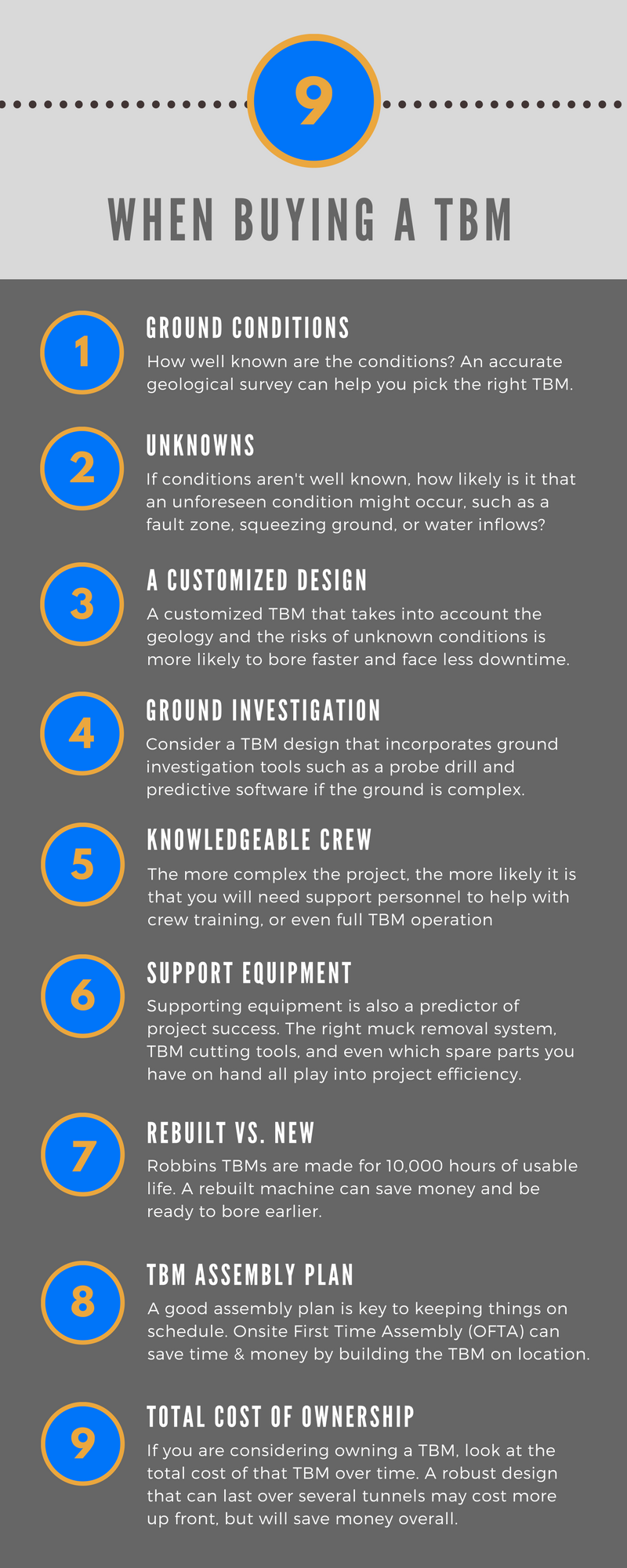Author: Keri Lin
罗宾斯敞开式吉林断层再创中国隧道掘进新纪录
2018年5月中旬,吉林第三标段隧道的直径7.9 m罗宾斯主梁式掘进机创下新纪录。工地举行了一个仪式以庆祝隧道施工的出色表现及提前竣工。“我从一开始就参与了这个项目。这项工程比计划提前147天竣工。该项目以1423.5米/月的速度刷新了中国7至8米直径的掘进机的最高月掘进纪录。机器已经连续三个月达到每月1,000米以上。我为这些成就感到骄傲。”承包商北京振冲公司(BVEC)副总工程师、吉林引松项目副总经理吴志勇说道。
考虑到所遇到的困难地质条件,提前近五个月完成24.3公里是一项重大的成就。岩石类型从凝灰岩到花岗岩、砂岩和安山岩不等,具有多个断层带条件,几乎需要连续的围岩支护。岩石强度在35至206兆帕之间变化很大。承包商列举了许多促成快速前进速度的因素:“这是罗宾斯机器稳定可靠的性能,以及现场服务人员的专业。罗宾斯团队的合作、合理的工作进度安排和先进的技术都使该项目取得了高效的掘进速度,”吴志勇表示。
罗宾斯主梁式掘进机采用独特的组合钢板条麦纳利支护系统(通过在掘进机顶部护盾钢精排储存仓安装预制钢板条以防止松动岩石移动)、钢丝网和喷射混凝土,掘进穿越总共24个断层带。掘进机是专门为应对恶劣条件而设计的。“在多变的地面条件下,特别是软弱、松软、破碎的岩石,优化的系统和合理的机器设计确保了有效的掘进进度。罗宾斯独特的抓取系统、连续推进系统、液压驱动、顶部支撑和稳定的刀盘减少了刀具的磨损。主梁内的高效带式输送机允许从刀盘到机器后部快速清除渣土,从而确保了掘进机的良好进展,”吴志勇继续说道。
吉林三标隧道是吉林引松供水工程的一部分,全长736.3公里,是迄今为止中国最大规模的引水工程。一旦投入使用,输水管道将从第二松花江上游的丰曼水库引水至长期缺水的吉林省中部地区。这些地区包括长春市、四平市、周边8个县、所辖26个乡镇。该项目将优化水资源配置,完善区域生态系统,确保吉林省人民的粮食生产和水安全。
2018澳洲隧道峰会
Event Name: Australian Tunneling Conference
Dates: October 15-16, 2018
Location: Sydney, Australia
Venue: SMC Conference & Function Centre
Meet us down under in Sydney, Australia as we attend the Australian Tunneling Conference from October 15 through 16. Stop by stand 11 to discuss current techniques being used on Robbins projects throughout the world.
2018胡志明市地铁线路基础设施项目会议
Event Name: Ho Chi Minh City MRT Lines Infrastructure Projects Conference 2018
Dates: July 24-26, 2018
Location: Ho Chi Minh City, Vietnam
Venue: Sheraton Saigon Hotel & Towers
The Robbins Company looks forward to attending the Ho Chi Minh City MRT Lines Infrastructure Projects Conference in Ho Chi Minh City Vietnam. Meet us at our table between July 24 through 26 to discuss projects operating nearby, such as the Thuong Kon Tum project, or others world-wide.
拯救和翻新掘进机:班加罗尔南马地铁的经验
In this blog, Robbins and guest blogger Barrie Willis, Manager Tunneling & Civil for iPS, share their experiences rebuilding and relaunching TBMs in the field.
TBM maintenance: it’s one of the most important factors predicting project success, but it is often glossed over. Experience shows, however, that maintenance plays just as much a part in the excavation rates as the proper TBM design. Regular maintenance can keep future rebuild costs low and keep equipment efficiency high while maximizing advance rates.
Conversely, a lack of maintenance, improper operation, and/or severe ground conditions can result in undue wear and slow advance rates. In a worst case scenario, it can even require rescuing and refurbishing a TBM. Such a case occurred at Bangalore, India’s Namma Metro, where several TBMs required recovery and refurbishment after operating in abrasive ground. Teams from both Robbins and iPS were called in to evaluate and rescue TBMs on separate sections of the tunnel.
The Robbins Experience
Two European-manufactured EPB TBMs “Krishna” and “Kaveri” were launched from the South Ramp station at the Namma Metro project in October and November of 2012, and were slated to bore three sections of metro tunnel each, totaling 1,550 m. While the first 400 m long drive from South Ramp to City Market station went well, the TBMs encountered severe ground conditions on the second, 432 m long drive from City Market to Chickpet Station.
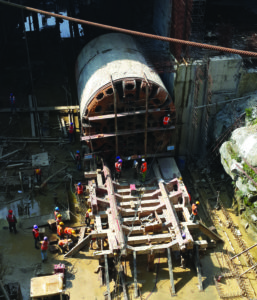
Robbins refurbished the two EPBs but did not change any of the machine design features.
Difficult Conditions
The drives took 12 and 22 months, respectively, and were hampered by a mixed face comprising hard granite and soil with high groundwater levels. Tunneling took place near fragile, historic building foundations in some cases hundreds of years old. The TBMs in this section encountered large boulders as well as reinforced blocks of concrete that seriously damaged the TBM cutterheads. These challenges required regular cutterhead interventions but at the same time there was an inability to grout unstable areas from the surface due to congested residential areas.
It was at this point that the contractor, along with owner Bangalore Metro Rail Corporation Ltd. (BMRCL), approached Robbins and asked them to take over the operations of the TBMs—the critical path tunnels needed to be brought back up to speed. The last 750 m drive between Chickpet and Majestic stations was all that stood in the way of opening a substantial section of Namma Metro’s Phase 1.
Robbins Signs On
After obtaining agreement from the project owner and the contractor, Robbins took over the responsibility for all aspects of the underground operations. A team of over 60 staff including TBM operators, TBM technicians, ring builders, a grouting team, and others began work. Robbins was also responsible for running surface installations and equipment such as the grout batching plant, gantry cranes and power supply. The contractor provided a team of people including surveyors, QC engineers, and loco operators who reported directly to the Robbins site management team.
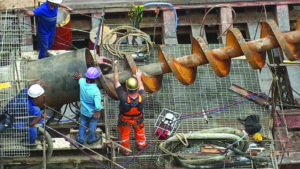
Robbins Field Service guided the refurbishment and assembly of the two competitor-manufactured EPBs.
The Robbins crew carried out refurbishment of the two TBMs, keeping the designs of the machines in tact while installing Robbins cutting tools in both cutterheads. In particular TBM “Krishna” underwent 112 days of repairs and testing. The refurbishment, and subsequent assembly and launch of the two machines, was carried out even as the Chickpet station was being constructed in order to mitigate any further delays. The two TBMs were re-launched in 2015 on their last drive—in March for TBM “Kaveri” and in December for TBM “Krishna”.
Challenging Ground Continues
Difficult conditions were encountered during the bore: the initial 160 meters of the drive was found to consist of residual soil, gradually transitioning into a mixed face of soil and highly weathered granite over the following 100 m. The mixed face conditions then gave way to a full face of fresh granite in the last 50 meters of boring.
The zones of transition were particularly difficult, with soil occasionally falling in due to the vibrations during tunneling. The conditions also made it impossible to maintain hyperbaric air pressure during cutterhead interventions. This problem was overcome by pumping a weak-mix grout solution into the ground surrounding the TBM. The solution permeated into existing voids and effectively prevented air from percolating through to the surface. A period of approximately 36 hours was initially required for curing of the grout solution. However, on-site trials with various additives enabled the standing time to be reduced to 12 hours.
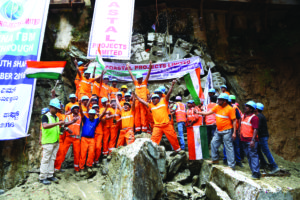
Robbins and crews celebrate the breakthrough of TBM “Kaveri”.
A Resounding Success
Despite the challenges, the TBMs were able to achieve advance rates of 50 mm per minute in highly weathered rock and 22 mm per minute in sections of competent hard rock. TBM “Kaveri” completed its final breakthrough in June 2016. The second TBM “Krishna” had the advantage of known geology and completed its excavation in about nine months on September 28, 2016.
The iPS Experience
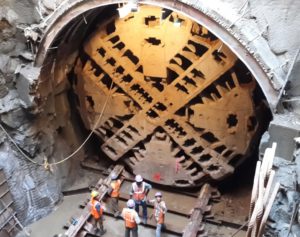
When the TBM emerged from the rescue shaft most cutters and grill bars were worn away.
On another section of the recently completed Namma Metro, iPS rescued and refurbished a stuck TBM from another European manufacturer, and then operated it for owner Bangalore Metro Rail Corporation (BMRC) alongside the project’s original contractor.
Initial Inspection
iPS found severe wear—the cutterhead was essentially bare, and the cutters, disc boxes, cutter mountings and grill bars had been worn away. On inspection a serious crack in the screw conveyor was found and the flights had been severely worn. The TBM had been operating for 12 months and had bored 300 m of abrasive ground with insufficiently thorough maintenance. Geology consisted of weathered granite with a high quartz and feldspar content, 130 MPa UCS, and was often mixed with softer soils. It came to a standstill below the main railway lines at a major Bangalore metro station.
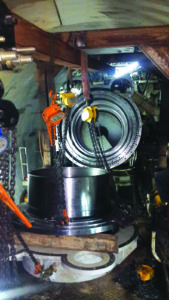
iPS crews had to rebuild the machine inside the tunnel.
Rebuild & Recovery Plan
iPS was able to build an intermediate shaft and refurbish the TBM to the point that it could advance into that shaft for further rebuild work including a replacement cutterhead. But the rebuild work itself was not easy—sourcing parts in India was a challenge, with smaller parts being brought in from Germany and other countries. A new cutterhead was shipped to the site by air freight. Crews dismantled the TBM to inspect and repair the screw conveyor, hydraulic system, PLC, and main drive. The TBM was relaunched in August 2015.
A Second Chance
Once the TBM had started up again, iPS then trained the crew on the importance of maintenance and inspections. They went over cutterhead interventions, what to look for, and how to prevent significant damage.
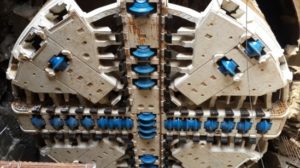
The cutterhead shown was shipped to the site by air freight, as sourcing parts was a challenge.
The training and TBM rebuild were a success—despite continued abrasive geology and mixed face conditions the machine completed the remaining 630 m of its drive in seven months. Frequent interventions were undertaken to maintain and inspect the machine. Breakthrough occurred on April 19, 2016.
Key Takeaways
Like any piece of machinery, it is essential to consider the total life cycle and to take steps to maximize the efficiency and life of the equipment through good operation and maintenance. Contractors should work with equipment suppliers to learn of the maintenance that is required—both scheduled and in response to changing geology.
When a project begins, err on the side of caution: do too many inspections, more than you think are necessary, to get a feel for how the machine reacts in different geologies. Geological surveys are extremely important, but they don’t always reveal every feature, so in the event the machine encounters unexpected geology, even more inspections will be necessary than normal. Above all, avoid complacency: just because a TBM is a large steel machine with a metal cutterhead and cutters doesn’t mean that nothing can damage it.
The proof is in the multitude of successful projects around the world: TBMs can and have shown their ability to excavate projects at world-class rates of advance even in very difficult conditions. With proper maintenance and operation, a TBM can last over many kilometers of tunnel and years of use.
欧洲首个跨模式隧道掘进机在莫格里克引水隧道突破
2018年5月3日,一条直径为6.2米的罗宾斯跨模式掘进机(XRE)在地下洞室贯通,标志着阿尔巴尼亚第一条隧道掘进完成。由承包商利Limak操作的掘进机也是第一台在欧洲作业的跨模式掘进机,并在包括蛇绿岩、砂岩、角砾岩和粉砂岩复理石的地质下掘进。
“刀盘和刀具已经取得了优异的性能,”Limak的掘进机经理Engin Gur说。掘进机在2018年4月实现了每月高达648米的速度,在一天内达到了37.4米。跨模式掘进机没有遇到高压水,因此在整个掘进过程中都采用硬岩双护盾作业模式。
行。令人印象深刻,”罗宾斯现场服务主管Max Walker说。在掘进机的整个作业过程中,罗宾斯的现场服务人员留在现场,以提供指导和故障排除。
在采用现场首次安装调试方案(OFTA)后,机器于2016年11月始发,使机器能够在工地进行初步组装。施工人员在接下来的230米的时间里缓慢地增加了产量。Walker说:“地质条件很好,我们几乎没有更换刀具,在掘进过程中只使用了20把刀具。”隧道掘进机以3个8小时轮班的方式在隧道内掘进和安装衬砌时进行两阶段灌浆。“这个项目的工作人员创造了一个友好的工作环境;他们让每天上班都很愉快。他们是很好的合作伙伴,”他补充说。
虽然掘进机不需要密封,但独特的机器设计考虑了预计的高进水风险。跨模式掘进机XRE使用带式输送机,而不是螺旋输送机来清除淤泥,因此淤泥槽需要能够在涌水的情况下密封。因此,舱壁设计有一个大型密封门,刚好位于带式运输机上方。这些泄压闸门也可以在半土压平衡模式下使用:由于切割室中的压力,闸门将被压力打开,材料将溢出到皮带上。当压力降低时,闸门会自动关闭,再次关闭密封室。在极端情况下,闸门可以密封,超前钻机/注浆钻可用于钻孔、注浆和密封水。此外,撑靴和内伸缩盾设计有充气密封件,以进一步防止水的涌入。
随着贯通的完成,注浆将继续在掘进机后面的管片进行。不会增加额外的衬砌,预计隧道将于2019年5月投入运营。
6.7公里长的莫格里克引水隧道(Moglicë)是迪沃水电站(Devoll)项目的一部分,该项目是一个自建-所有-运营-移交(BOOT)方案,旨在沿迪沃河(Devoll)修建两个水电站,名为莫格里克和班加(Banja)。该项目由挪威电力公司Statkraft AS所有。完成的德维尔水电站项目将使阿尔巴尼亚的发电量增加17%,装机容量将达到242兆瓦。
挖掘土耳其最具挑战性的项目:格瑞德输水隧道
在土耳其中部的格雷德输水隧道(Gerede),由于首都安卡拉严重和长期干旱,一条长31.6公里的供水线路被指定为国家重点项目。从格雷德河取水(并输送至Çamlıdere大坝),一旦完工,这将是土耳其最长的引水隧道。
但完成隧道本身就是一个障碍。该项目被称为土耳其目前正在建设的最具挑战性的隧道,理由充分。最初提供给隧道掘进的三个标准双护盾掘进机中,有两个在大量泥浆和碎片流入后无法修复地卡住。2016年,一个跨模式掘进机机始发,以挖掘最后9公里的隧道,但要做到这一点,它需要跨越数十个断层带,并承受高达20巴的强水压。
为了实现这一点,机器设计了许多独特的功能,包括密封能力高达20巴的压力。如果出现大量进水,停止的掘进机将抑制水或淤泥,并留出时间进行预固结灌浆。该机器还配备了底部螺旋输送机和独特的刀盘设计,有助于在硬岩石和混合地面有效运输渣土等特点。本文讨论了机器在极其困难的条件下的性能,并概述了有待克服的挑战以及如何克服这些挑战。本文还介绍了这一土耳其紧急项目的独特之处,以及在现有隧道深处组装和发射机器的独特后勤要求。
在150米深的混合地质下挖掘墨西哥城的巨型隧道:TEO污水隧道第五标段
墨西哥城拥有1,900万居民,是世界上最大的城市之一,但其大部分基础设施都在努力跟上。从1970年到200年,人口翻了一番,如今产生了40立方米/秒的废水;然而,容量仅为10立方米。此外,该市的大部分废水未经处理,通过一个开放的下水道和地下管线网络流动。
国家水资源委员会(NationalWaterCommission,Conagua)已经制定了一项关键性的计划,以缓解健康问题,以及如果污水管道出现故障可能引发灾难性洪水的可能性。他们计划的主要内容是该国最大的基础设施项目 Túnel Emisor Oriente(TEO)。这条长62公里的隧道将连接到墨西哥城的第一个污水处理厂,并将缓解洪水。在地球上一些最复杂的地质中,总共有六个隧道掘进机正在挖掘隧道。
本演示将介绍TEO项目第五标段的挑战,检查深井下组装的设备,以及针对极为困难的地质条件和隧道限制下盾构机的改良和性能。
最新的切削技术在坚硬岩石中高效掘进
对于硬质岩石中的掘进机,需要考虑的两个最重要的参数是刀具性能和穿透率。这两个考虑因素相互高度依赖,因为刀具通常是限制机器推力的关键部件——一个决定净穿透率的关键变量。在这种情况下,优化刀具性能非常重要,不仅要优化净穿透率,而且要最大限度地减少更换刀具所需的时间,最大限度地延长钻孔时间。在过去的五年里,人们对刀具开发进行了大量投资,使刀具能够承受最具挑战性的条件。本文介绍了近年来推动刀具技术进步的发展和挑战,以及这些发展在近期项目中的成果。
在Bahce-Nurdag铁路隧道挖掘土耳其最坚硬的岩石
土耳其东南部的加济安泰普省以安纳托利亚东部断层内的复杂断裂岩石为特征,现在是一个重要的铁路隧道项目的位置。该省人口近170万,正通过一条连接 Bahçe镇和 Nurdağı镇的铁路线对其公共交通进行翻修。Bahce-Nurdag铁路隧道由两条平行的9.75 公里隧道组成,由新奥法挖掘850 米和全断面掘进机挖掘8.9 公里。
承包商Intecar Yapi Turizm Elektrik Insaat San采用罗宾斯直径8米的单护盾构掘进机开挖两段隧道。本项目以混合地面条件为主,从磨粒、夹石英岩脉的砂岩和泥岩到强风化页岩和白云质灰岩。到目前为止,隧道掘进机遇到了土耳其有史以来挖掘的最坚硬的岩石,岩石强度在136至327兆帕之间。
本文将分析掘进机的性能,以及在困难的地面条件下,滚刀的性能和磨损情况。它将讨论掘进机设计和项目物流,包括土耳其偏远地区的现场掘进机组装。最后,根据工程结果,提出了适合于硬质磨蚀岩的掘进机设计和刀具使用的建议。
选择掘进机时要考虑的9件事
Purchasing a Tunnel Boring Machine is no small consideration. Many factors are equally important to the price, and they can mean the difference between project success and significant downtime. Download our complimentary checklist to learn about the nine most important things to consider:
Learn more! Download the checklist for choosing a TBM here.

 Close
Close  Menu
Menu 
